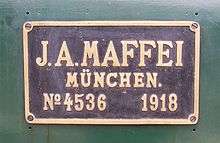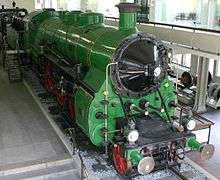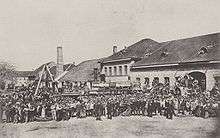Maffei (company)



Maffei was a manufacturer of railway locomotives based in Munich, Germany. Established in 1836, it prospered for nearly a century before going bankrupt in 1930 and becoming amalgamated with the firm of Krauss to form Krauss-Maffei. Following another seventy years of prosperity Krauss-Maffei merged with Demag and Mannesmann in 1999, the resulting conglomerate in turn being sold to Siemens AG.
Perhaps J. A. Maffei's most famous product was the S3/6 4-6-2 locomotive of 1908.
Foundation
In 1836, Joseph Anton, Ritter von Maffei established the "J. A. Maffei" locomotive works in the English Garden district of Munich. The aim was to make Bavaria competitive in the machine industry. From these small beginnings a world-renowned locomotive works eventually developed.
Maffei, amongst other things, involved itself with the building of the Augsburg Munich line and supported Johann Ulrich Himbsel in the building of the Munich - Starnberg line. Maffei, at Lake Starnberg, built their first steamer "Maximilian". By 1926 they had built 44 steam ships.
Railways

In 1864 they delivered their 500th locomotive. Maffei, as a Munich town councillor, was praised for the building of the Hotel Bayerischer Hof. Well-known products of the locomotive works are the Bavarian S 2/6 express locomotive which held the 1907 German speed record of 154.5 km/h) and the Bavarian S 3/6. Examples of the S 3/6 are preserved in the Deutsches Museum in Munich and in the Nuremberg Transport Museum.
In 1930 the form of J.A.Maffei went into bankruptcy and in 1931 merged with the Krauss Company to form Krauss-Maffei. The Maffei mansion in Feldafing, by Lake Starnberg, today houses a museum and exhibitions.
Krauss Maffei
Krauss-Maffei developed from the 1931 union of the two Munich companies Maffei and Krauss & Co. Both had built major German locomotives; Maffei also built other steam driven vehicles. The headquarters of the firm remain in Munich.
Tank Production
Maffei to this day remains a major tank producer, having outshopped some 10000 Leopard tanks since the 1950s. Many Nato allies have used them. With the commencement of German rearmament the military product range technology was revived. In 1963 Krauss Maffei developed the Leopard (replaced, commencing 1972 by the leopard 2); Production of the AAA armored vehicle commenced in1976.
Maffei has a diverse military product line:
- Gepard air defense
- Self-propelled howitzer 2000
- MARS artillery rocket launching system
- Fennek reconnaissance car
- Boxer armored transport vehicle
- Dingo all protection vehicle
- Terrier crew car
- Mungo light air landing vehicle
In the 1970s Krauss Maffei was involved in the development of the Transrapid suspension railway.
Plastics
The company had produced injection moulding equipment since 1957. In 1964 the company Eckert & Ziegler GmbH was taken over.
In 1986 the plastics equipment division was separated and became Krauss Maffei Plastics Engineering, and in 2000 took over the relevant trademarks.
Merger
Krauss Maffei merged with Demag and Mannesmann in 1999 and in turn the new conglomerate was sold to Siemens AG.
Co-operation between Wegmann and Krauss Maffei was already well established. Wegmann had supplied the turrets, among other things, for many Krauss Maffei tanks. The "tank family" comprises not only battle tanks but also combat engineering vehicles, air defense, artillery and reconnaissance and transportation tanks.